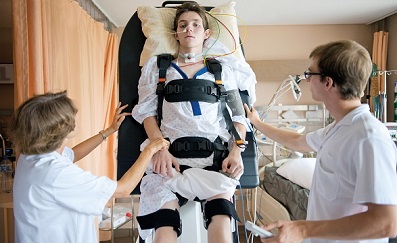Meeting the 2023 National Clinical Guideline for Stroke with the Erigo
Hocoma
In this second blog we’re taking a look at the National Clinical Guideline for Stroke, which defines recommended best practices within stroke care in the UK. This guideline provides much-needed updates to recommendations on rehabilitation, psychological and emotional support, and return to work services, amongst many other changes.
In light of these recommendations, we’re reviewing all our clinical solutions and sharing the ways in which these meet the 2023 guidelines. This is to help clinicians assess the rehabilitation technology we offer and how these devices can support patients recovering from a stroke, as well as support the stroke services offering this rehabilitation.
This week we’re looking at the Erigo, a robotic tilt table device that combines gradual verticalisation with robotic leg movement and FES to ensure the safety of your patients while they are in an upright position. This leads to muscle activation, improved muscle pump function, venous return, and increased cardiovascular activity, which allows for patients to be trained intensively and safely from a very early stage of rehabilitation.
Missed part one? Check out how the ROBERT® meets the National Clinical Guideline for Stroke.
About the Erigo
The mobilisation and verticalisation of immobile patients can be very challenging, and can be unsafe for patients and therapists alike. The Erigo allows early and safe mobilisation, even in acute care.
The Erigo combines gradual verticalisation with robotic movement therapy, which ensures the safety of your patients while they are in an upright position. The robotic leg movement and the cyclic leg loading conducted by the Erigo is critical for the stimulation of the central nervous system. This means that your patients can be trained intensively and safely from a very early stage of rehabilitation.
The Erigo‘s Functional Electrical Stimulation (FES) further increases the afferent stimulation of patients, and thereby their cardiovascular stability, during early verticalisation. The electrical activation of key leg muscles supports the increase of blood flow in the patients’ lower limbs. This leads to improved venous return which helps to maintain stroke volume and blood pressure. Furthermore, therapy with the Erigo FES improves cerebral blood flow and muscle strength in lower extremities leading to recovery of motor function. The Erigo‘s Functional Electrical Stimulation is fully synchronised with the robotic leg movements.
The Erigo is developed by Hocoma and distributed in the UK by Summit Medical and Scientific. Read more about the Erigo here.
Meeting the 2023 Stroke Guidelines
So how does the Erigo robotic rehabilitation device meet the National Clinical Guideline for Stroke?
1. The Erigo supports how in the first two weeks post-stroke, therapy should be provided in frequent, short interventions every day.
2. The Erigo mobilises patients between 24 and 48 hours of stroke onset.
3. The Erigo helps how people with stroke should be offered cardiorespiratory training or mixed training.
4. The Erigo helps to provide three hours of multidisciplinary therapy a day.
5. The Erigo supports the delivery of individualised one-to-one therapy, structured semi-supervised practice, and group work.
6. The Erigo helps people with weakness being taught task-specific, repetitive, intensive exercises or activities to increase their strength.
Get in touch with Summit Medical and Scientific today to discuss integrating the Erigo into your clinical practice.
About Summit Medical and Scientific
Summit Medical and Scientific are passionate about the power of rehabilitation technology.
We represent clinical technology leaders Hocoma, Motek and Life Science Robotics to provide the total solution for rehabilitation in the UK. Our partners have developed innovative therapy devices using robotics, sensors and virtual reality for early and acute rehabilitation, gait and balance therapy, arm and hand therapy, body weight support and more. View all of our clinical solutions here.
Get in touch with Summit Medical and Scientific today to find out more about incorporating state-of-the-art rehabilitation technology into your practice.
You can also follow us on Facebook, Twitter and LinkedIn, and subscribe to our newsletter for the latest updates.

